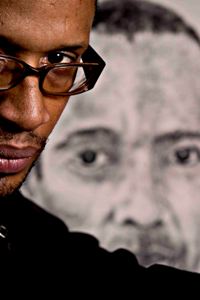HARLEM’S VANGUARD
The Visual & Culinary Art of Carl Cassell

By Saada Branker
Carl Cassell’s serendipitous stumble across his latest baby is a tale worth hearing. But a simple tour of his new 2,800 square-foot space — transformed from a den of inequity into a restaurant and bar — confirms that for a while something for the people has been in the making. The tell tale signs: Cassell’s inimitable art on the walls, the co-ownership with Toronto’s renowned DJ Carl Allen, and the complex culinary creations brewing in the kitchen. No doubt, Harlem is a designed happening. Call it planned parenthood.
The afternoon of my interview with Cassell I check out his stomping ground. Heading east from the corner of Church and Richmond Streets I walk past his newborn project, inspecting the neighbors. An upscale Thai restaurant, an Irish pub, a co-operative, even a parking lot around the corner — all are just steps away from Harlem’s front entrance. A glance upward reveals a condo tower under construction a few blocks south.
Inside the two-storey restaurant and bar (home of Club Rock It back in the day) is Cassell, with his jacket still on and knuckles dry from working in the back. He describes how Harlem came about.
The Find
Last summer his first restaurant, the Irie Food Joint on Queen Street West, was mad busy, having matured nicely into an urban hub during the six years since its establishment. Cassell was in a position to offer his help in plastering and painting a friend’s yoga studio, which had been badly charred by fire. One day he wiped at the thick soot on a window. The black dirt grudgingly came off the glass, exposing to Cassell a view inside an adjacent building.
“I start seeing the hood on top of this building,” he says. “All of a sudden I got a full perspective on the building itself. That window was my only vantage point.”
The Jamaican native schools me, explaining a hood is what extracts the air from the restaurant. “It’s one of the most expensive things to put in,” he adds. That equipment told him the building was zoned as a restaurant. From there he called his agent inquiring. “And that’s where it started,” says Cassell. “I found out it was available.”
In actuality, he soon discovered the space was last used as a private sex club — beds and all. It took an entire gutting of the interior to unearth the foundation from where he and his small team of builders would start; not to mention cleansing an energy he describes as “an interesting type of darkness.”
And the creativity is bright in Harlem, despite its small but quaint space. The interior is masterfully designed in a rustic chic flair. Highlights include the enticing VIP room behind the DJ platform, and the slim counter right outside the kitchen. Patrons can enjoy a snack stop, with platters of finger foods resourcefully laid out, compliments of a chef extraordinaire who this owner lovingly calls “Ange.”
The Birth of the Vanguards
The timing of this founding was notable. Cassell had been running with his creative energy. Last February 27 he celebrated his 36th birthday at Irie by unveiling his Vanguard Series II — a procession of portraits; his first installment was made in 2003. Featured in both are filmmakers, writers, publishers, musicians, producers, artists, a chef, a police officer, an events producer, visual artists, a DJ, and an opera singer. Each portrayal cleverly captures the nuances of people whose energy and creations attracted him.
What stands out about Cassell’s art is each likeness was created entirely with synthetic hair — a medium that lands this inventor in a class by himself.
“I know when I’m experiencing something significant,” says Cassell, a man known for his elevated ponderings and a near-obsessive compulsive work ethic.
The same night of his Vanguard II debut, the former Jerk Pitt dishwasher was approached by Nike Canada to enter a competition commemorating World Cup Soccer. Entitled Joga Bonito (Play Beautiful), the mission was to reflect the culture of the eight qualifying World Cup national teams by building a Gitoni table. Cassell jumped to represent Brazil (or rather he politely insisted).
Months later his visually awesome table won, beating out the installments of seven other respected artists from across Canada. Brazil lost in the quarterfinals against France, but Cassell continued to burn a winning streak
So cleaning that pane of dirt and soot at the yoga studio that summer’s day was like scratching yet another winning ticket. Once again the devoted father of three girls claimed his good fortune.
The Unwelcoming Committee
With properly aligned kismet comes some disjointed challenges. Namely, a small group of disgruntled residents from the next door co-op have been questioning Harlem’s existence.
At first it was a grievance over the noise level from Harlem’s opening night on December 11th. Windows were reinforced to accommodate, says Carl. He even walked into a displeased neighbor’s apartment to hear for himself the intolerably loud music.
“You could barely hear anything. Her roommate was sound asleep,” says Cassell.
A few weeks after our interview he learns some unnamed complainants described his patrons as “undesirables.” “Can you believe that, in f**kin’ 2007? We’re undesirables?” he asks incredulously.
Renaissance Relived
The irony isn’t that incredible. Anyone familiar with the Harlem Renaissance in New York can perhaps draw some parallels with the Harlem in Toronto. It was in the early 1900s when African Americans left their mid-town ghettos and settled in the flourishing suburb of Harlem. In 1910 Black realtors were buying blocks of property; triggering the encroachment of the creative and educated classes from across the country and the Caribbean. Their White neighbors fled and real estate prices fell.
But what rose to stardom was Negro pride exemplified in African American art and literature. The creators were activists, writers, artists, sculptors, musicians, performers, publishers and photographers. Names such as Langston Hughes, Zora Neale Hurston, Richard Wright, James Van Der Zee, Duke Ellington, Louis Armstrong, Bessie Smith, Josephine Baker and the happening joint known as The Cotton Club were some of the names that gained recognition throughout North America for years to come.
By 1930 the Depression arrived and the Renaissance in Harlem ended, but not without influencing a sister movement at that time called La Négritude. Its founders were Leopold Sédar Senghor, the president of Senegal in West Africa, Léon Damas, a former professor at Howard University born in French Guiana and Aimé Césaire, a Martinican poet. Their writings in the pages of L’Étudiant Noir inspired a similar socio-political consciousness that rejected the inherent racism of French colonialism.
Looking Forward
The significance of these movements is not lost on Cassell, who graduated from the University of the West Indies in economics and then McMaster University in business administration. He’s been saying the new Harlem will reflect Toronto’s own creative class through its guest artists and DJs.
“This is from scratch, ground up again. I know a lot more people now than when I did when I first opened Irie,” he says, admitting there are disadvantages opening Harlem during the post-holiday time when people are hibernating and hung up on bills.
“People think I have money coming out my ass, that’s not the case…when I first opened Irie they felt obligated to support it. But now that I’ve been doing it for five years, there’s a presumption that I’m wildly successful and don’t need the support no more. When do you not need support? Especially when you’re doing something as risky as this business, he maintains. “But I am confident about what it is that I’m doing.”
As for the notion that his kind is not welcome on Richmond Street East, he bristles but is far from breaking. His excitement about what he and Allen have in store for their clientele remains solid. "I love what I do and to a certain extent I do know how to do it…Putting Harlem in this spot is a huge accomplishment.”
|







